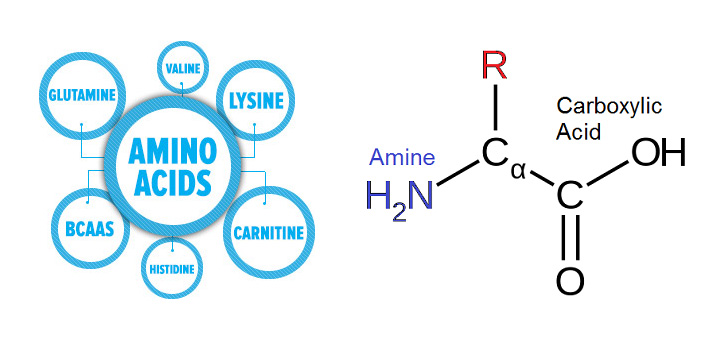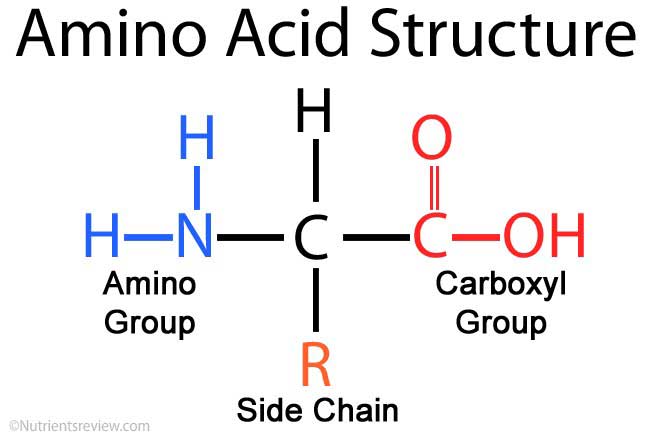What are the different types of amino acids? According to the body’s ability to produce amino acids, amino acids are divided into three categories:
A list of essential amino acids:
There are 9 essential amino acids that cannot be produced by the human body in sufficient quantities, but must be consumed from food containing them daily, and not getting enough of any of these amino acids can lead to serious health problems.

Histidine:
In the digestion process, hemoglobin contains 8.5% histidine. By stimulating the stomach to produce digestive juices, it also improves memory, ability to perform mental and cognitive activities, aids in the removal of large amounts of heavy metals, increases the effects of some cancer drugs, and forms histamine protein in the body. Among its functions, it plays a key role in the allergic reaction of the body as well as in the expansion of blood vessels, which increases blood flow.
Fish, poultry, meat, whole grains, seeds, and nuts contain histidine.
Isoleucine:
Many physiological functions are influenced by isoleucine. Additionally to increasing the secretion of many hormones, isoleucine is necessary for the formation of hemoglobin, regulation of energy levels, and the detoxification of nitrogenous waste products. Cheese, seeds, nuts, lentils, eggs, meat, fish, and poultry contain isoleucine.
Lucien:
In foods containing high-quality proteins, leucine is usually abundant. The protein contains all the essential amino acids and is involved in metabolic processes that produce the energy required to make these proteins. Legumes, soybeans, beans, and milk products are among its sources.
Lysine:
Calcium absorption and protein synthesis require lysine. Among them are collagen, elastin, enzymes, hormones, and energy, as well as its role in immune function. Quinoa, soy, black beans, pumpkin seeds, eggs, and meat are all sources of it.
Methionine:
Cellular metabolism relies heavily on methionine. Methionine helps break down fats, which reduces fat accumulation in the arteries, and, in addition to strengthening the digestive system, it can be converted to cysteine, which helps get rid of heavy metals.
Phenylalanine:
A number of amino acids and enzymes rely on phenylalanine for their production and function. Tyrosine, which is involved in the construction of some neurotransmitters, is converted from phenylalanine. Dopamine and neuropathy are examples of this.
Triune:
Structural proteins contain threonine as one of their basic components. The skin and connective tissues contain collagen and elastin, which are essential for the metabolism of lipids and immune function. Wheat germ and cottage cheese are among its sources.

Tryptophan:
Some hormones are formed from tryptophan in chemical reactions, which are necessary for baby growth. Along with serotonin, melatonin regulates sleep as well.
Wallin:
As a result of its connection between the central nervous system and muscle coordination, vitamin valine helps maintain mental activity, emotional stability, and coordination, as well as nutrients that provide energy, muscle growth and regeneration, tissue regeneration, and repair.
It contains many resources. These include beef, chicken, milk, fish, and whole grains, such as oats, plus beans, peas, and seeds such as pumpkin seeds, flax seeds, sunflower seeds, etc.
Amino acids that are not essential:
The body can make 11 types of these acids, which are not necessarily obtained from food on a daily basis. In addition to hematopoietic cells, most body cells are capable of synthesizing non-essential amino acids from glucose.
Alanine:
Alanine is one of the most widely used amino acids for the formation of proteins and for their metabolism. Tryptophan, vitamin B6, organic acids, and sugars provide energy for the central nervous system and muscles, as well as lowering cholesterol and strengthening immunity. You can obtain it by eating meat, seafood, seeds, and nuts.
Arginine:
In addition to maintaining hormone function, immune system function, wound healing, and dilation of blood vessels, arginine aids the kidneys in eliminating waste products. Most protein-rich foods contain arginine. Among them are red meat, chicken, fish, dairy products and their derivatives, whole grains, beans, and soybeans.
Asparagine:
The central nervous system is maintained by asparagine. Therefore, it is necessary to control restlessness. It is found in chicken, beef, seafood, eggs, milk and milk products, soy, asparagus, and whole grains.
Aspartic acid:
In addition to maintaining the nervous system’s function, aspartic acid plays an important role in the production and secretion of hormones throughout the body. Animal sources include wild birds, shellfish, and plant resources such as avocado, asparagus, and molasses.
Glutamic acid:
The body converts glutamic acid into glutamate. This chemical compound may play a role in the learning process and may also help reduce stomach acid loss by helping nerve cells in the brain receive and send nerve signals.
Protein-rich foods provide it. Eggs, meat, fish, chicken, dairy products and their derivatives, and some legumes. Sources such as beans, lentils, and others.
Glutamine:
In addition to strengthening brain function, glutamine is needed to make DNA and RNA, and it is found in ricotta cheese, cottage cheese, spinach and parsley. Raw vegetables, cabbage, meat, milk, chicken, and mother’s milk are also important sources.
Glycine :
Skin contains glycine. Besides healing wounds, it also acts as a neurotransmitter, and it can be found in meat, fish, dairy products, and legumes.
Proline:
Cells transmit nerve signals using proline. All protein-rich foods contain proline, but milk and meat contain the most.
Serin:
One of the proteins that make up the brain is serine. Serine helps produce proteins for the immune system and helps muscles grow. Eggs contain serine. It is found in meat and fish, especially oysters, as well as soybeans, lentils, peas, and some nuts. Nuts and seeds such as walnuts, almonds, and peanuts
Amino acids that are conditionally essential:
Among the amino acids, it consists of non-essential amino acids, as well as other amino acids that do not need to be available in the body on a daily basis, so called because they are only essential in certain situations. When the body is unable to produce enough of them due to illness, stress, or injury. As a result, it must be prepared from food or food supplements, which include:
arginine
glutamine;
cysteine;
tyrosine;
Proline.
glycine;
Serin
Ornithine
General functions of amino acids:
A major function of amino acids is to synthesize proteins. Each type of protein has a different sequence of amino acids, and this order determines the function and three-dimensional shape of the protein, and the most important protein is made up of 50 to 2000 amino acids.
Antibodies are proteins produced by the immune system that destroy antigens. The body considers them harmful and foreign proteins. Among them are bacteria, viruses, parasites, fungi, and dangerous chemicals.
Hormones are produced by glands and travel through the circulatory system to regulate other organs and systems’ physiological functions.
Neurotransmitters: Proteins that communicate between nerve cells, gland cells, muscle cells, or other nerve cells.
Enzymes: Enzymes play a key role in many chemical reactions inside cells and accelerate them by reading the genetic information stored on DNA, which is a deoxyribonucleic acid.
Below is a table showing the recommended daily amount of essential amino acids for the body:
Essential amino acid | Recommended amount (in mg) |
Lucien | 42 |
lysine | 38 |
Phenylalanine | 33 |
Wallin | 24 |
Triune | 20 |
isoleucine | 19 |
you must | 19 |
Histidine | 14 |
Tryptophan | 5 |


